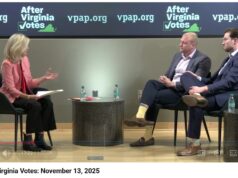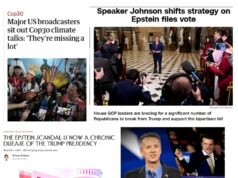The following is by State Senator Lynwood Lewis, partly in response to this argument by Lloyd Snook, regarding the constitutional amendment question, “Should a county, city, or town be authorized to provide a partial tax exemption for real property that is subject to recurrent flooding, if flooding resiliency improvements have been made on the property?”
As the Senator representing the Sixth District of Virginia, I was elected to represent the entirety of the Eastern Shore, Mathews County, roughly half of the city of Norfolk and a very small portion of Virginia Beach. More so than any other Senate District in the state of Virginia, the 6th is facing a future threatened by sea level rise and recurrent flooding. The district includes Tangier Island, where residents are at risk of being some of the first climate change refugees in the United States. It includes the most flood-prone areas of Norfolk – neighborhoods that don’t just see flooding during storm events, but are regularly subjected to “sunny day” tidal flooding. Recent studies show that nowhere in the country are seas rising faster than in Virginia Beach.
Because of the unique threat that sea level rise and flooding pose to the 6th district, combating these challenges has been a central focus of mine as a legislator. We need a multi-prong approach to address what has grown into a multi-billion dollar problem, to include action and contribution at all levels of government and engagement of residents and businesses across the region. While change and the implementation of solutions surrounding sea level rise and flood mitigation has not been as swift or sweeping as many of us may like, we have made significant strides over the past couple of years.
At the state level, the past few legislative sessions have seen some hard-fought battles on sea level rise won. In 2016, I carried legislation that created the Shoreline Resiliency Fund, a revolving low-interest loan fund to help homeowners and businesses elevate their properties to safeguard against sea level rise. Going into the 2019 session, we are seeking revenue sources for this fund, including contributing revenues from Virginia joining the Regional Greenhouse Gas Initiative, legislation I’ve carried the past two years but is unfortunately still a partisan hot potato. This past session, raised bipartisan awareness around sea level rise and recurrent flooding and intense political pressure locally enabled us to pass key legislation establishing a cabinet-level position focused solely on addressing flooding and adaptation. That position is now filled by Rear Admiral Ann Phillips, an expert on sea level rise and an advocate for developing a regional authority to combat recurrent flooding – another major upcoming legislative lift.
Another piece of legislation intended to provide our localities with another tool in their toolkit in order to combat sea level rise and recurrent flooding is one that will come before Virginia voters on November 6 in order to become law: a proposal to give localities – if they so choose – the ability to grant a partial tax exemption to property owners who invest in flood mitigation improvements on their property. I introduced this legislation in 2017, and it has just recently come under some scrutiny. I wanted to take the opportunity to address some of the concerns that have been brought to my attention over the past week.
For background, because Virginia is a Dillon Rule state, local governments cannot grant any new tax exemptions or credits without being given explicit permission by the General Assembly. This is done in the form of a Constitutional Amendment, which must pass the General Assembly in two consecutive legislative sessions and then be voted on by Virginians. This legislation passed with significant support in 2017 and 2018 and received no major opposition. It is meant to serve as a single tool in what is a multi-pronged, multi-layered approach to addressing sea level rise.
Additionally, and perhaps most importantly, the passage of this amendment would not result in it immediately becoming law. The General Assembly must pass subsequent enabling legislation establishing the parameters for its implementation. This means that the General Assembly will set the “terms and conditions” that will apply to property owners if a locality were to establish this partial tax exemption. As a legislative body, we will be tasked with establishing standards for qualification as well as laying out what localities would be empowered to determine if they chose to implement the tax exemption. The amendment already excludes new construction and unoccupied real estate, but parameters could also include income/property value limitations on exemption qualifications, what types of mitigation a property owner can undertake to be eligible for the exemption and where a property must be located in order to qualify for the exemption (i.e., a flood zone, a flood plain, etc.)
Many of the concerns that have been brought to my attention would be addressed in the required enabling legislation prior to the amendment becoming law. Outside of those concerns, I do believe that there are a few aspects of the amendment that have been misconstrued. One that has seemed to have gained some steam is that this will be abused by developers at the taxpayer’s expense. This is not only untrue, but is likely not possible. The language of the accompanying bill for the Flooding Amendment outlines that the tax exemption is only available for improvements to current properties subject to recurrent flooding – not new construction. The phrase “improved real estate” is not up for creative interpretation; it is a legal term. “Improved” means that a building must exist on the property. Properties must also be occupied. If developers were to buy up properties in low-lying areas, tear them down and rebuild, they would not be eligible for this exemption. And, as aforementioned, income limitations can be set to further ensure there is not a work around on this front and that the legislation does exactly what is intended: allow homeowners who are subject to flooding threats and recurrent flooding the opportunity to more easily finance flood mitigation efforts on their properties.
The amendment also does not supersede zoning or building codes, which have been subject to increased scrutiny by local governments and planning commissions over the past few years. Just this past month, the Hampton Roads Planning District Commission adopted its first-ever regional sea level rise planning policy. As is noted by the HRPDC, this policy identifies and agrees upon specific sea level rise predictions for planning scenarios to use when making local land use policy and engineering decisions. Again, the General Assembly can set parameters on the implementation of the exemption, but this amendment is necessarily accompanied by increased awareness at a local level around the necessity of considering sea level rise and flooding risk when developing building codes and approving projects for development.
I also want to take the time to quell the notion that this would only apply to folks who live on large waterfront properties and would result in the taxpayer subsidizing these homes. In the district I live in and represent, it is not necessarily Oceanfront and Bayfront homes that are the most at-risk to flooding. In some cases that is so, but many of these properties are already built up off the land to mitigate flooding. Many of the neighborhoods that are most at risk are located in close proximity to the water, but not directly on the water. These are middle-class homes that were built 30, 40, 50 years ago – if not more – and many of which are still occupied by original homeowners. When these homes were built, they were not in flood zones – not by a long shot. Now, middle-class homeowners are trapped with declining property values, rising flood insurance costs and loss of livelihood. To be clear, this also amounts to a decline in property tax revenue for cities, counties and towns. The economic hit is two-fold. The argument is made that these individuals should be incentivized to leave their homes, not improve them through mitigation efforts. I do believe that we are facing a future where tough decisions will have to be made regarding what neighborhoods should be the focus of monetary efforts to save and the abandonment of other neighborhoods. That being said, I do not believe it to be realistic to insist that we expect all homeowners living in areas that are subject to flooding to take an economic hit, abandon their homes and their own family histories and move elsewhere. Incentivizing residents who live in severely flood prone areas to sell their properties in order to return those properties to marshland or to allow bodies of water that were built on to again flow where they were meant to flow will certainly need to be a tool we utilize. Indeed, we have already seen localities start to do this; Norfolk has entered into a partnership with FEMA that focuses on this exact effort. It is not a complete solution, however, and localities will require a multitude of tools and approaches in their master plans, as will the Commonwealth.
As the current co-chair of the Joint Subcommittee on Coastal Flooding, I can attest that our coastal localities and universities, as well as our environmental and business communities are all working non-stop to find collaborative solutions and funding sources to combat sea level rise. I did not weigh this amendment lightly, and I hope I’ve been able to calm some of the concerns. This amendment is not the final product – it is the vehicle to establish what will be one tool of many as we work to combat rising seas and mitigate flooding. The enabling legislation would ensure that this partial tax exemption – already permissive – serves its purpose and intent, which is not to encourage new development in low-lying areas or exacerbate environmental concerns, but to assist localities in their efforts to address the causes, costs and effects of recurrent flooding. As put forth in the Virginian-Pilot endorsement, localities would be subject to any parameters laid out by the General Assembly and would then have to hold public hearings and assess if the political will is present within their jurisdiction to establish the exemption.
I do encourage you to vote ‘yes’ on this amendment on November 6 and welcome input on the enabling legislation.



![Saturday News: “Trump’s latest tariff TACO probably won’t make your life more affordable”; “The Epstein Email Cache: 2,300 Messages, Many of Which Mention Trump”; “[MTG] questions if Trump is still the ‘America First’ president”; “Jim Ryan tells all: ‘What did the Governor know, when did he know it?’”](https://bluevirginia.us/wp-content/uploads/2025/11/montage1115-238x178.jpg)







![Saturday News: “Trump’s latest tariff TACO probably won’t make your life more affordable”; “The Epstein Email Cache: 2,300 Messages, Many of Which Mention Trump”; “[MTG] questions if Trump is still the ‘America First’ president”; “Jim Ryan tells all: ‘What did the Governor know, when did he know it?’”](https://bluevirginia.us/wp-content/uploads/2025/11/montage1115-100x75.jpg)

